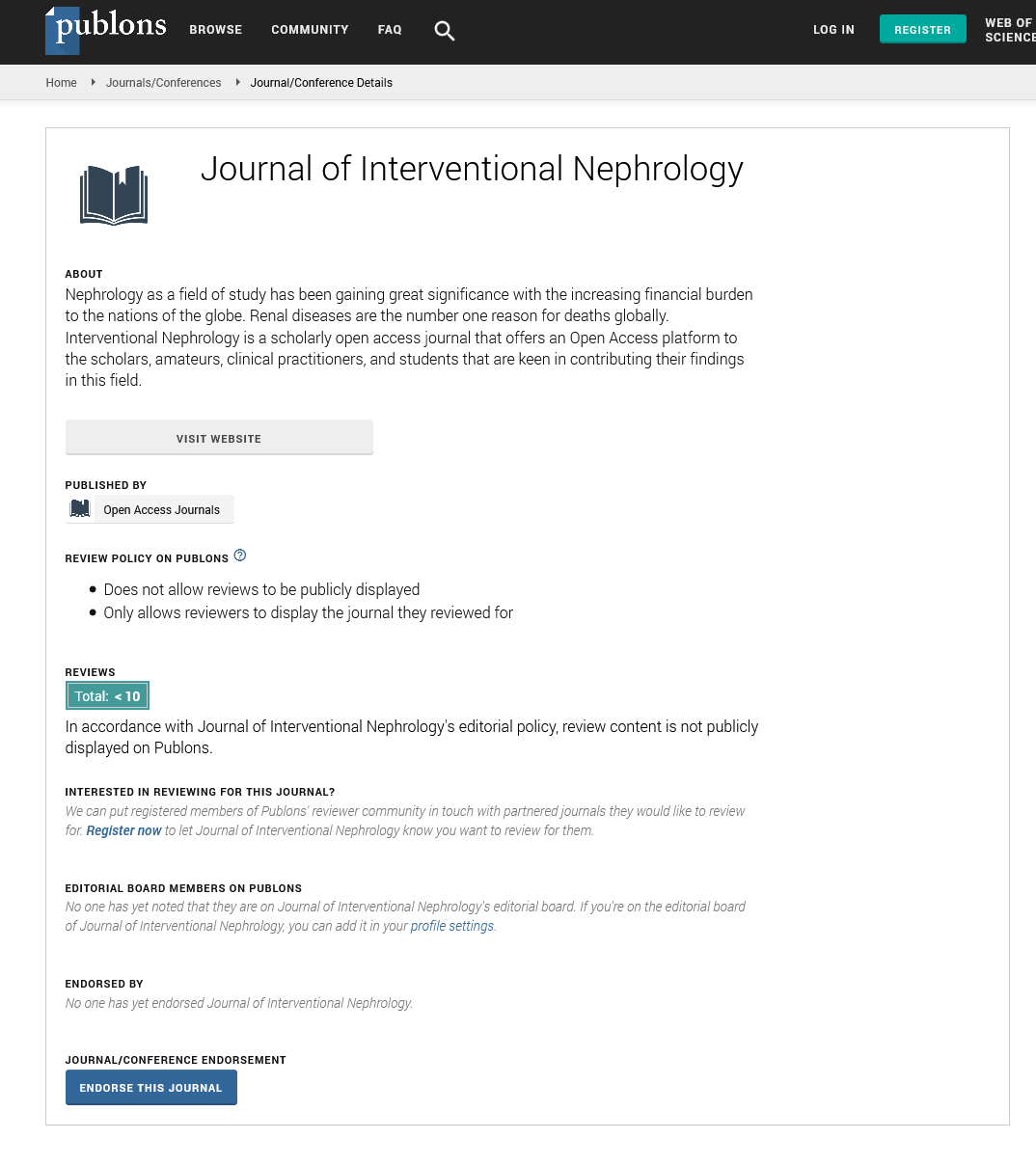Perspective - Journal of Interventional Nephrology (2024) Volume 7, Issue 5
Acid-Base Balance: Understanding Its Importance in Health
- Corresponding Author:
- David Sharma
Department of Medicine,
MVN University,
Italy
E-mail: SharmaDWS5789@QW.esedu
Received: 20-Sep-2024, Manuscript No. OAIN-24-148453; Editor assigned: 23-Sep-2024, PreQC No. OAIN-24-148453 (PQ); Reviewed: 07-Oct-2024, QC No. OAIN-24- 148453; Revised: 14-Oct-2024, Manuscript No. OAIN-24-148453 (R); Published: 23-Oct-2024, DOI: 10.47532/oain.2024.7(5).323-325
Introduction
Acid-base balance is a critical physiological process that maintains the body’s pH within a narrow range, ensuring optimal cellular function and metabolic processes. The body’s pH is tightly regulated by various systems, including the respiratory and renal systems, to prevent acidosis (an excess of acid) or alkalosis (an excess of base). This article delves into the mechanisms of acid-base balance, its significance in health, and the implications of disturbances in this balance.
The Importance of pH in the body
The pH scale ranges from 0 to 14, with 7 being neutral. A pH less than 7 indicates acidity, while a pH greater than 7 indicates alkalinity. The human body functions best at a slightly alkaline pH of about 7.35 to 7.45. Deviations from this range can disrupt metabolic activities, enzyme functions, and cellular integrity, leading to severe health consequences.
Effects of pH imbalance
Acidosis: This condition occurs when the pH falls below 7.35. It can result from increased production of acids, decreased excretion of acids, or a loss of bicarbonate (a base). Symptoms may include fatigue, confusion, shortness of breath, and increased heart rate.
Alkalosis: This condition occurs when the pH rises above 7.45. It can result from excessive loss of acids or an increase in bicarbonate. Symptoms may include muscle twitching, hand tremors, and light-headedness.
Description
Understanding the mechanisms behind acidbase balance helps in identifying and managing conditions that lead to these imbalances.
Mechanisms of acid-base regulation
The body employs three primary mechanisms to maintain acid-base balance:
Buffer systems
Buffers are substances that can absorb excess hydrogen ions (H⁺) or release them as needed to maintain pH. The major buffering systems in the body include:
• Bicarbonate buffer system: The most
important buffer system, involving
carbonic acid (H₂CO₃) and bicarbonate
(HCO₃⁻). It helps maintain pH in the
blood and extracellular fluid.
• H₂O+CO₂↔H₂CO₃↔H⁺+HCO₃⁻\
text{H₂O}+\text{CO₂}\leftrightarrow\
t e x t { H ₂ C O ₃ } \ l e f t r i g h t a r r o w \
t e x t { H ⁺ } + \ t e x t { H C O ₃ ⁻ }
H₂O+CO₂↔H₂CO₃↔H⁺+HCO₃⁻
• Protein buffer system: Proteins in the
blood can bind or release H⁺ ions, helping
to stabilize pH. Hemoglobin in red blood
cells acts as a buffer by binding H⁺ ions
during oxygen transport.
• Phosphate buffer system: Involves
dihydrogen phosphate (H₂PO₄⁻) and
hydrogen phosphate (HPO₄²⁻). It plays
a significant role in intracellular buffering
and in the kidneys.
Respiratory regulation
The respiratory system helps maintain acidbase balance by regulating the levels of carbon dioxide (CO₂) in the blood. CO₂ is a byproduct of metabolism and reacts with water to form carbonic acid, which dissociates into H⁺ and bicarbonate.
• Hyperventilation (rapid breathing) decreases
CO₂ levels, leading to a rise in pH (alkalosis).
• Hypoventilation (slow breathing) increases
CO₂ levels, resulting in a drop in pH
(acidosis).
• The respiratory response to acid-base
imbalances occurs rapidly, usually within
minutes.
Renal regulation
The kidneys play a crucial role in maintaining acid-base balance by excreting excess acids or bases. They manage the levels of bicarbonate and hydrogen ions through:
• Reabsorption of bicarbonate: The kidneys
can reabsorb bicarbonate from the urine
back into the bloodstream, which helps
neutralize excess acids.
• Excretion of hydrogen ions: The kidneys
can also excrete hydrogen ions into the
urine, reducing acidity.
Renal regulation is slower than respiratory regulation, typically taking hours to days to affect significant changes in pH.
Acid-base disorders
Disturbances in acid-base balance can lead to various disorders, primarily classified into four categories:
Respiratory acidosis
This occurs when there is an accumulation of CO₂ due to impaired ventilation, leading to increased carbonic acid. Common causes include:
• Chronic Obstructive Pulmonary Disease
(COPD)
• Severe asthma
• Neuromuscular disorders
Symptoms include confusion, drowsiness, and shortness of breath. Treatment focuses on improving ventilation and addressing the underlying cause.
Respiratory alkalosis
This occurs when CO₂ levels decrease due to hyperventilation, resulting in a reduction of carbonic acid. Common causes include:
• Anxiety or panic attacks
• High altitudes
• Fever
Symptoms may include dizziness, tingling in the extremities, and palpitations. Treatment may involve re-breathing CO₂ or addressing the underlying cause of hyperventilation.
Metabolic acidosis
This occurs when there is an excess of acid or a loss of bicarbonate. Common causes include:
• Diabetic ketoacidosis
• Renal failure
• Lactic acidosis
Symptoms can include rapid breathing, confusion, and fatigue. Treatment typically involves addressing the underlying cause, and in severe cases, bicarbonate therapy may be necessary.
Metabolic alkalosis
This occurs when there is an excess of bicarbonate or a loss of acid. Common causes include:
• Vomiting
• Diuretic use
• Excessive bicarbonate ingestion
Symptoms may include muscle twitching, hand tremors, and irritability. Treatment focuses on correcting the underlying cause and restoring electrolyte balance.
Diagnosis of acid-base disorders
Diagnosis of acid-base disorders typically involves blood tests to measure Arterial Blood Gases (ABGs), including:
• pH: Indicates acidity or alkalinity.
• PaCO₂: Partial pressure of carbon dioxide,
reflecting respiratory function.
• HCO₃⁻: Bicarbonate levels, indicating
metabolic status.
• PaO₂: Partial pressure of oxygen, providing
insights into oxygenation.
Interpreting these values helps determine the type of acid-base disorder and guide treatment.
Treatment and management
The management of acid-base disorders depends on the underlying cause and the specific disorder:
• Respiratory acidosis: Treatment may
involve bronchodilators, oxygen therapy, or
mechanical ventilation.
• Respiratory alkalosis: Addressing anxiety,
providing reassurance, or re-breathing
techniques may be effective.
• Metabolic acidosis: Treatment may involve
bicarbonate therapy or addressing the
underlying cause, such as insulin in diabetic
ketoacidosis.
Conclusion
Acid-base balance is vital for maintaining homeostasis and ensuring the proper functioning of biochemical processes. Understanding the mechanisms that regulate this balance, the consequences of disturbances, and effective management strategies is essential for healthcare professionals. By addressing acid-base imbalances promptly, we can improve patient outcomes and enhance overall health. As research continues to evolve in this area, staying informed about new developments and treatment modalities will be crucial for advancing nephrology and related fields.


